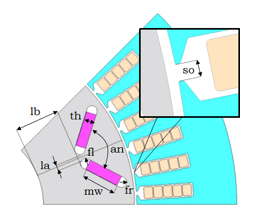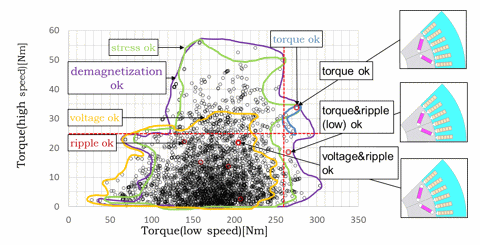Contents
1.The Need for Multi-Objective Optimization for Traction Motor Design
2. Multi-Objective Optimization Calculation Using GA
3. Conclusion and Future Work
4. References
1.The Need for Multi-Objective Optimization for Traction Motor Design
Tractions motors for HEVs and EVs require different performances depending on the driving conditions and may be restricted not only in terms of magnetic fields performance but also in terms of structure and heat performances. For example, high torque and low torque ripple are required in the low speed / high load driving state, and a low torque ripple and a voltage limitation are imposed in the high speed / low load driving state etc. In this way, as a motor design method that satisfies a plurality of required values, multi-objective optimization calculation may be performed. By setting the required values as an objective function, and constraint conditions, to minimize the objective function, we will be able to search for an optimal design.
Usually, when performing such multi-objective optimization calculations, a sensitivity analysis is performed to clarify design variables contributing to the minimization of the objective function to simplify the search for the optimum solution from a huge design space within a realistic time range. Only then the optimization calculation is performed. On the other hand, even with the result of a sensitivity analysis, it may be difficult to narrow down the design space because all design variables present high sensitivity on the objectives. In such a case, it is thought that it is a reasonable approach to perform a multi-objective optimization calculation using a Genetic Algorithm (hereinafter called “GA”) to find the best solution and make a design proposal [1]. In this paper, a GA optimization calculations will be carried out for a problem where the narrowing down of the design space is difficult based on the results of sensitivity analysis. Furthermore, it was shown that a good compromise to the design solution can be found.
In this paper, the multi-objective optimization calculation has 12 design variables (8 geometric variables, 4 circuit variables) with 6 objective functions (maximize torque, minimize torque ripple, minimize voltage at revolutions of 1,200 rpm and 9,000 rpm), and one constraint condition (stress less than 20 MPa). The analysis model is shown in Fig. 1 and the requirements of the traction motor are shown in Table 1.

Fig. 1 Drive Motor model
Table 1 Required value of the motor
| Low speed (1,200rpm) | High speed (9,000rpm) | |
|---|---|---|
| Torque [Nm] | ≧260 | ≧25 |
| Ripple [%] | ≦30 | ≦30 |
| Voltage [V] | <700 | <700 |
| Demagnetization ratio [%] | ≦0 | ≦0 |
First, a sensitivity analysis of the design variables (geometric) is performed before the multi-objective optimization calculation. For the sensitivity analysis, an 8-variable, 3-level L18 orthogonal array was created. The sensitivity was then calculated using the Taguchi method. The sensitivity was evaluated by taking into account the motor’s non-linearity and calculating two operating points of the motor: low load and high speed (9,000 rpm) and high load and low speed (1,200 rpm). The results of the analysis are shown in Fig. 2.

Multi-objective optimization calculation result by GA
You need to sign in as a Regular JMAG Software User (paid user) or JMAG WEB MEMBER (free membership).
By registering as a JMAG WEB MEMBER, you can browse technical materials and other member-only contents for free.
If you are not registered, click the “Create an Account” button.
Create an Account Sign in



